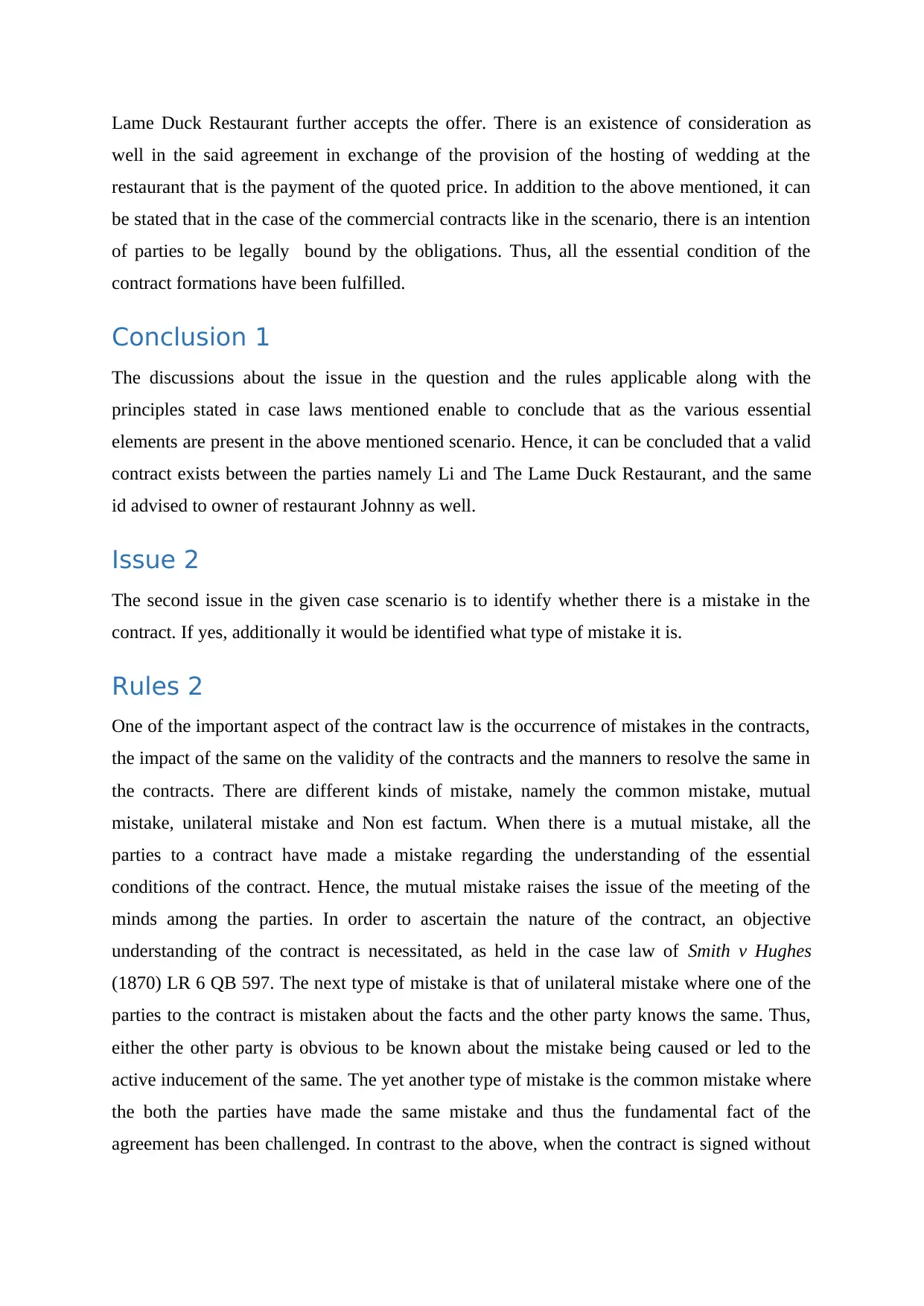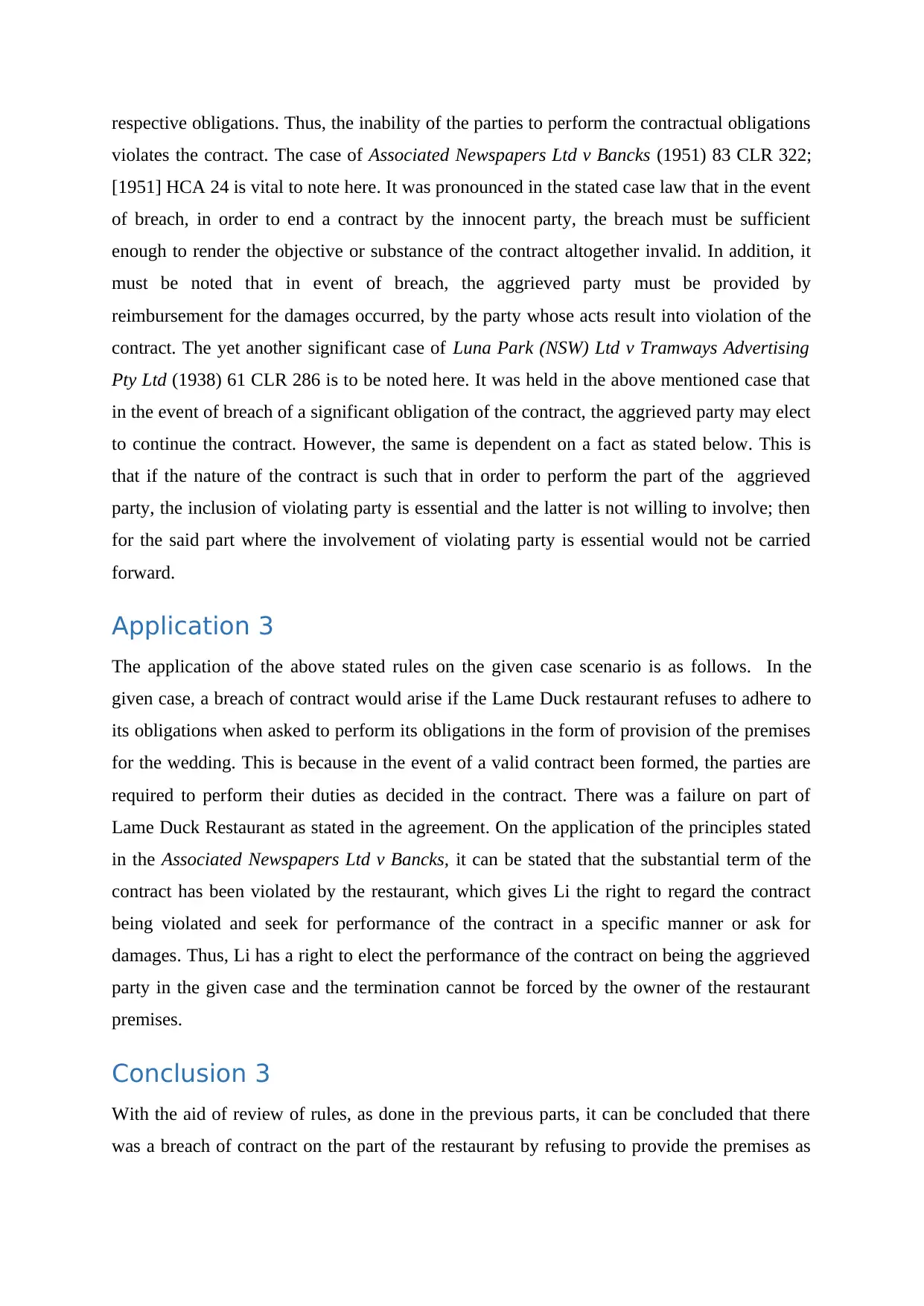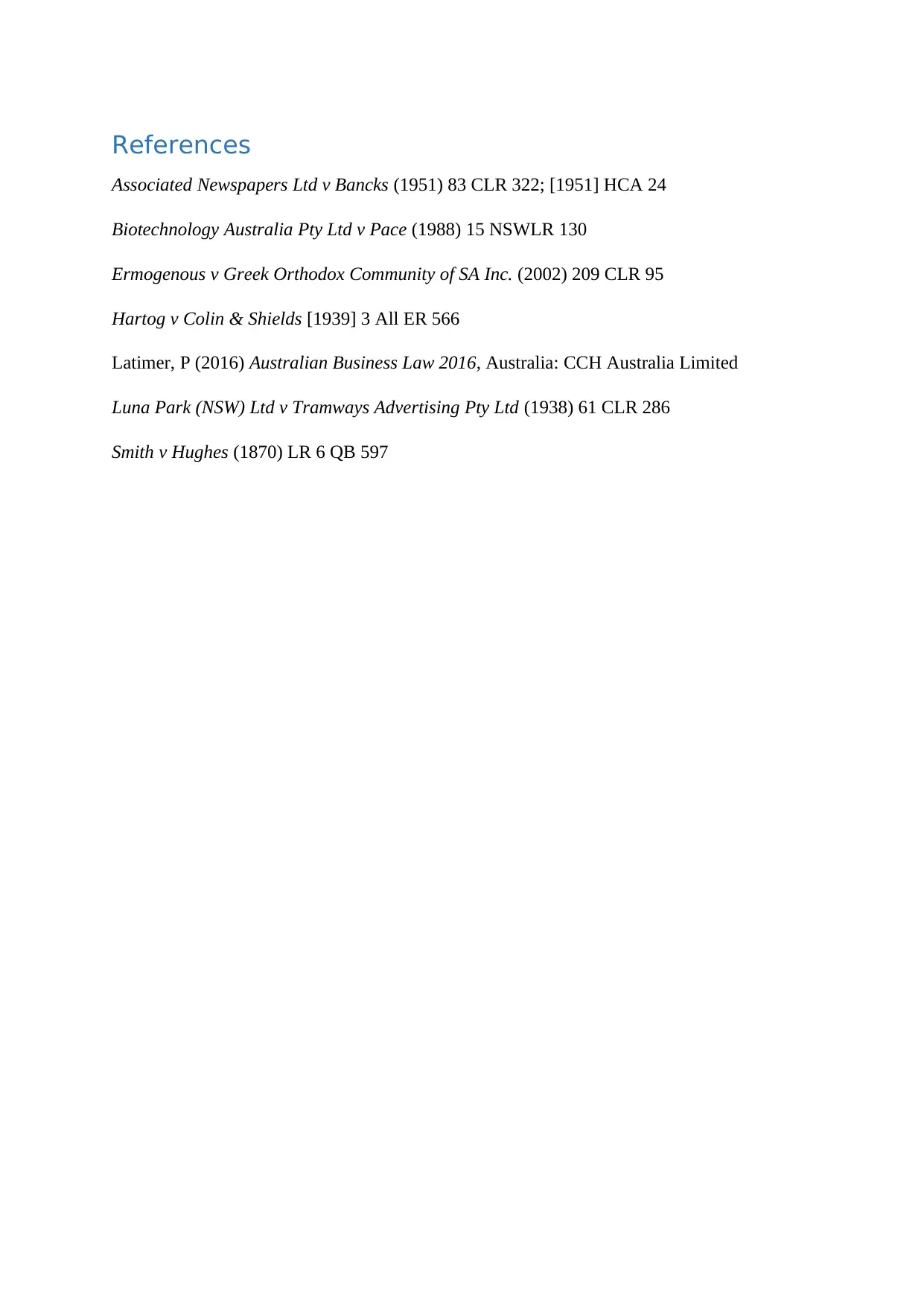Business Law Case Study: Contract Formation, Mistakes, and Breach
VerifiedAdded on 2022/11/01
|8
|2035
|186
Case Study
AI Summary
This case study analyzes a business law scenario involving a wedding venue booking at the Lame Duck Restaurant. The assignment explores three key issues: the formation of a valid contract between Li and the restaurant, the existence and type of any mistake in the contract, and the consequences of the restaurant's refusal to provide the venue. The analysis delves into contract law principles, including offer, acceptance, consideration, intention to be legally bound, and the certainty of terms. It examines different types of mistakes, such as unilateral mistakes, and the implications of breach of contract. The solution applies relevant case laws, such as *Ermogenous v Greek Orthodox Community of SA Inc.*, *Smith v Hughes*, and *Associated Newspapers Ltd v Bancks*, to determine the legal outcomes and advise the parties involved, concluding that a valid contract exists, a unilateral mistake occurred, and the restaurant breached the contract.

Introduction to business law
Paraphrase This Document
Need a fresh take? Get an instant paraphrase of this document with our AI Paraphraser

Contents
Issue 1.........................................................................................................................................2
Rules 1........................................................................................................................................2
Application 1..............................................................................................................................2
Conclusion 1...............................................................................................................................3
Issue 2.........................................................................................................................................3
Rules 2........................................................................................................................................3
Application 2..............................................................................................................................4
Conclusion 2...............................................................................................................................4
Issue 3.........................................................................................................................................4
Rules 3........................................................................................................................................4
Application 3..............................................................................................................................5
Conclusion 3...............................................................................................................................5
References..................................................................................................................................6
Issue 1.........................................................................................................................................2
Rules 1........................................................................................................................................2
Application 1..............................................................................................................................2
Conclusion 1...............................................................................................................................3
Issue 2.........................................................................................................................................3
Rules 2........................................................................................................................................3
Application 2..............................................................................................................................4
Conclusion 2...............................................................................................................................4
Issue 3.........................................................................................................................................4
Rules 3........................................................................................................................................4
Application 3..............................................................................................................................5
Conclusion 3...............................................................................................................................5
References..................................................................................................................................6

Issue 1
The first issue in the given case scenario is the determination of whether there is an existence
of a contract between the parties in question.
Rules 1
The Australian Contract Law prescribes certain essentials which must exist in order to
confirm a valid formation of contract between the parties (Latimer, 2016). As per the contract
law, a contract is referred to as the agreement duly formed between the parties that can be
enforced at the courts. The first condition is that presence of offer and acceptance thereon.
The former refers to the willingness of one party to create a contract and the communication
thereof is vital. The advertisements are regarded as an invitation to treat, unless these are
comprised of certainty in terms of all the key terms. A valid acceptance constitutes
acceptance to all the chief terms along with the communication thereof. The second key
condition is known as the intention of being legally bound by the contract as held in the
renowned case law of Ermogenous v Greek Orthodox Community of SA Inc. (2002) 209 CLR
95. This means that the parties must agree that the rights and obligations indicated in the
agreement hold the potential to be enforced at the courts. The existence of consideration is
the next key element, which denotes a payment of some kind, not necessary in the form of
money, in exchange of the promise received. The case of Biotechnology Australia Pty Ltd v
Pace (1988) 15 NSWLR 130 is important to note here which states that some form of
consideration should support the agreements to regard the latter as binding. The yet another
important element is the certainties of terms, which should not be vague and must expressly
or implied state certain obligations to be performed by the parties. Further to state, the parties
must possess the legal capacity to enter into the contracts and the object of the contract must
not be immoral or illegal, else the contracts would be void. Hence, the essential conditions
must exist at time of formation of contract to regard a contract validly formed.
Application 1
The above stated rules when applied to the given case scenario, leads to the following
mentioned useful insights. The physical menu is the invitation to treat by the Lame Duck
Restaurant to the public. When parties accept the invitation to treat, the same becomes an
offer. In the given case, there is an acceptance of the invitation to treat by Lin as per the given
rates in the physical menu and the same becomes an offer. The accounts department of the
The first issue in the given case scenario is the determination of whether there is an existence
of a contract between the parties in question.
Rules 1
The Australian Contract Law prescribes certain essentials which must exist in order to
confirm a valid formation of contract between the parties (Latimer, 2016). As per the contract
law, a contract is referred to as the agreement duly formed between the parties that can be
enforced at the courts. The first condition is that presence of offer and acceptance thereon.
The former refers to the willingness of one party to create a contract and the communication
thereof is vital. The advertisements are regarded as an invitation to treat, unless these are
comprised of certainty in terms of all the key terms. A valid acceptance constitutes
acceptance to all the chief terms along with the communication thereof. The second key
condition is known as the intention of being legally bound by the contract as held in the
renowned case law of Ermogenous v Greek Orthodox Community of SA Inc. (2002) 209 CLR
95. This means that the parties must agree that the rights and obligations indicated in the
agreement hold the potential to be enforced at the courts. The existence of consideration is
the next key element, which denotes a payment of some kind, not necessary in the form of
money, in exchange of the promise received. The case of Biotechnology Australia Pty Ltd v
Pace (1988) 15 NSWLR 130 is important to note here which states that some form of
consideration should support the agreements to regard the latter as binding. The yet another
important element is the certainties of terms, which should not be vague and must expressly
or implied state certain obligations to be performed by the parties. Further to state, the parties
must possess the legal capacity to enter into the contracts and the object of the contract must
not be immoral or illegal, else the contracts would be void. Hence, the essential conditions
must exist at time of formation of contract to regard a contract validly formed.
Application 1
The above stated rules when applied to the given case scenario, leads to the following
mentioned useful insights. The physical menu is the invitation to treat by the Lame Duck
Restaurant to the public. When parties accept the invitation to treat, the same becomes an
offer. In the given case, there is an acceptance of the invitation to treat by Lin as per the given
rates in the physical menu and the same becomes an offer. The accounts department of the
⊘ This is a preview!⊘
Do you want full access?
Subscribe today to unlock all pages.

Trusted by 1+ million students worldwide

Lame Duck Restaurant further accepts the offer. There is an existence of consideration as
well in the said agreement in exchange of the provision of the hosting of wedding at the
restaurant that is the payment of the quoted price. In addition to the above mentioned, it can
be stated that in the case of the commercial contracts like in the scenario, there is an intention
of parties to be legally bound by the obligations. Thus, all the essential condition of the
contract formations have been fulfilled.
Conclusion 1
The discussions about the issue in the question and the rules applicable along with the
principles stated in case laws mentioned enable to conclude that as the various essential
elements are present in the above mentioned scenario. Hence, it can be concluded that a valid
contract exists between the parties namely Li and The Lame Duck Restaurant, and the same
id advised to owner of restaurant Johnny as well.
Issue 2
The second issue in the given case scenario is to identify whether there is a mistake in the
contract. If yes, additionally it would be identified what type of mistake it is.
Rules 2
One of the important aspect of the contract law is the occurrence of mistakes in the contracts,
the impact of the same on the validity of the contracts and the manners to resolve the same in
the contracts. There are different kinds of mistake, namely the common mistake, mutual
mistake, unilateral mistake and Non est factum. When there is a mutual mistake, all the
parties to a contract have made a mistake regarding the understanding of the essential
conditions of the contract. Hence, the mutual mistake raises the issue of the meeting of the
minds among the parties. In order to ascertain the nature of the contract, an objective
understanding of the contract is necessitated, as held in the case law of Smith v Hughes
(1870) LR 6 QB 597. The next type of mistake is that of unilateral mistake where one of the
parties to the contract is mistaken about the facts and the other party knows the same. Thus,
either the other party is obvious to be known about the mistake being caused or led to the
active inducement of the same. The yet another type of mistake is the common mistake where
the both the parties have made the same mistake and thus the fundamental fact of the
agreement has been challenged. In contrast to the above, when the contract is signed without
well in the said agreement in exchange of the provision of the hosting of wedding at the
restaurant that is the payment of the quoted price. In addition to the above mentioned, it can
be stated that in the case of the commercial contracts like in the scenario, there is an intention
of parties to be legally bound by the obligations. Thus, all the essential condition of the
contract formations have been fulfilled.
Conclusion 1
The discussions about the issue in the question and the rules applicable along with the
principles stated in case laws mentioned enable to conclude that as the various essential
elements are present in the above mentioned scenario. Hence, it can be concluded that a valid
contract exists between the parties namely Li and The Lame Duck Restaurant, and the same
id advised to owner of restaurant Johnny as well.
Issue 2
The second issue in the given case scenario is to identify whether there is a mistake in the
contract. If yes, additionally it would be identified what type of mistake it is.
Rules 2
One of the important aspect of the contract law is the occurrence of mistakes in the contracts,
the impact of the same on the validity of the contracts and the manners to resolve the same in
the contracts. There are different kinds of mistake, namely the common mistake, mutual
mistake, unilateral mistake and Non est factum. When there is a mutual mistake, all the
parties to a contract have made a mistake regarding the understanding of the essential
conditions of the contract. Hence, the mutual mistake raises the issue of the meeting of the
minds among the parties. In order to ascertain the nature of the contract, an objective
understanding of the contract is necessitated, as held in the case law of Smith v Hughes
(1870) LR 6 QB 597. The next type of mistake is that of unilateral mistake where one of the
parties to the contract is mistaken about the facts and the other party knows the same. Thus,
either the other party is obvious to be known about the mistake being caused or led to the
active inducement of the same. The yet another type of mistake is the common mistake where
the both the parties have made the same mistake and thus the fundamental fact of the
agreement has been challenged. In contrast to the above, when the contract is signed without
Paraphrase This Document
Need a fresh take? Get an instant paraphrase of this document with our AI Paraphraser

the comprehension of the same or failure to understand the nature of the contract, the same is
regarded as Non est factum.
Application 2
The application of the above-mentioned rules to the given case scenario is stated as follows.
In the given circumstances, there is an existence of unilateral mistake on part of Summer and
there is no mistake from Li’s side. This is because, the restaurant had failed to update the
prices on the physical menu. Accordingly, a booking has been made by Li as per the rates on
one of the menus found on the tables. Hence, there is no mistake from the side of Li in terms
of the quoting of the rates or the understanding of the terms of the contract of booking of the
wedding. In contrast to this, there is a mistake from Summer’s end because the old quotations
were given by summer as per the earlier prices. In addition, Summer being an employee of
the restaurant is ought to be knowing the change in the rates of booking and the same was not
communicated to Li at the time of the formation of the contracts. The case of Hartog v Colin
& Shields [1939] 3 All ER 566 is vital to be noted here, in which it was pronounced that
when one of the parties are at commitment of mistake and the other is not, it would be
regarded as an unilateral mistake. In this event, the contract becomes void.
Conclusion 2
The discussions carried in previous part, aid to conclude that yes, there existed a mistake in
the formation of contract as per the situation stated. The said mistake was unilateral in nature
because of fault of one of the parties to the contract and accordingly the contract would be
rendered as void.
Issue 3
The issue in the given case study is to evaluate the consequence on refusal of the Lame Duck
Restaurant for the provision of the venue for the wedding when the same is obliged to
provide the venue.
Rules 3
The rules that are applicable in this part of the case scenario in context of the given issue are
stated as follows. On the formation of a valid contract by the parties, there is legal obligation
for the parties to perform the obligation stated therein and thus render valid performance of
the contract. The breach of contract arises when one of the parties fail to abide by their
regarded as Non est factum.
Application 2
The application of the above-mentioned rules to the given case scenario is stated as follows.
In the given circumstances, there is an existence of unilateral mistake on part of Summer and
there is no mistake from Li’s side. This is because, the restaurant had failed to update the
prices on the physical menu. Accordingly, a booking has been made by Li as per the rates on
one of the menus found on the tables. Hence, there is no mistake from the side of Li in terms
of the quoting of the rates or the understanding of the terms of the contract of booking of the
wedding. In contrast to this, there is a mistake from Summer’s end because the old quotations
were given by summer as per the earlier prices. In addition, Summer being an employee of
the restaurant is ought to be knowing the change in the rates of booking and the same was not
communicated to Li at the time of the formation of the contracts. The case of Hartog v Colin
& Shields [1939] 3 All ER 566 is vital to be noted here, in which it was pronounced that
when one of the parties are at commitment of mistake and the other is not, it would be
regarded as an unilateral mistake. In this event, the contract becomes void.
Conclusion 2
The discussions carried in previous part, aid to conclude that yes, there existed a mistake in
the formation of contract as per the situation stated. The said mistake was unilateral in nature
because of fault of one of the parties to the contract and accordingly the contract would be
rendered as void.
Issue 3
The issue in the given case study is to evaluate the consequence on refusal of the Lame Duck
Restaurant for the provision of the venue for the wedding when the same is obliged to
provide the venue.
Rules 3
The rules that are applicable in this part of the case scenario in context of the given issue are
stated as follows. On the formation of a valid contract by the parties, there is legal obligation
for the parties to perform the obligation stated therein and thus render valid performance of
the contract. The breach of contract arises when one of the parties fail to abide by their

respective obligations. Thus, the inability of the parties to perform the contractual obligations
violates the contract. The case of Associated Newspapers Ltd v Bancks (1951) 83 CLR 322;
[1951] HCA 24 is vital to note here. It was pronounced in the stated case law that in the event
of breach, in order to end a contract by the innocent party, the breach must be sufficient
enough to render the objective or substance of the contract altogether invalid. In addition, it
must be noted that in event of breach, the aggrieved party must be provided by
reimbursement for the damages occurred, by the party whose acts result into violation of the
contract. The yet another significant case of Luna Park (NSW) Ltd v Tramways Advertising
Pty Ltd (1938) 61 CLR 286 is to be noted here. It was held in the above mentioned case that
in the event of breach of a significant obligation of the contract, the aggrieved party may elect
to continue the contract. However, the same is dependent on a fact as stated below. This is
that if the nature of the contract is such that in order to perform the part of the aggrieved
party, the inclusion of violating party is essential and the latter is not willing to involve; then
for the said part where the involvement of violating party is essential would not be carried
forward.
Application 3
The application of the above stated rules on the given case scenario is as follows. In the
given case, a breach of contract would arise if the Lame Duck restaurant refuses to adhere to
its obligations when asked to perform its obligations in the form of provision of the premises
for the wedding. This is because in the event of a valid contract been formed, the parties are
required to perform their duties as decided in the contract. There was a failure on part of
Lame Duck Restaurant as stated in the agreement. On the application of the principles stated
in the Associated Newspapers Ltd v Bancks, it can be stated that the substantial term of the
contract has been violated by the restaurant, which gives Li the right to regard the contract
being violated and seek for performance of the contract in a specific manner or ask for
damages. Thus, Li has a right to elect the performance of the contract on being the aggrieved
party in the given case and the termination cannot be forced by the owner of the restaurant
premises.
Conclusion 3
With the aid of review of rules, as done in the previous parts, it can be concluded that there
was a breach of contract on the part of the restaurant by refusing to provide the premises as
violates the contract. The case of Associated Newspapers Ltd v Bancks (1951) 83 CLR 322;
[1951] HCA 24 is vital to note here. It was pronounced in the stated case law that in the event
of breach, in order to end a contract by the innocent party, the breach must be sufficient
enough to render the objective or substance of the contract altogether invalid. In addition, it
must be noted that in event of breach, the aggrieved party must be provided by
reimbursement for the damages occurred, by the party whose acts result into violation of the
contract. The yet another significant case of Luna Park (NSW) Ltd v Tramways Advertising
Pty Ltd (1938) 61 CLR 286 is to be noted here. It was held in the above mentioned case that
in the event of breach of a significant obligation of the contract, the aggrieved party may elect
to continue the contract. However, the same is dependent on a fact as stated below. This is
that if the nature of the contract is such that in order to perform the part of the aggrieved
party, the inclusion of violating party is essential and the latter is not willing to involve; then
for the said part where the involvement of violating party is essential would not be carried
forward.
Application 3
The application of the above stated rules on the given case scenario is as follows. In the
given case, a breach of contract would arise if the Lame Duck restaurant refuses to adhere to
its obligations when asked to perform its obligations in the form of provision of the premises
for the wedding. This is because in the event of a valid contract been formed, the parties are
required to perform their duties as decided in the contract. There was a failure on part of
Lame Duck Restaurant as stated in the agreement. On the application of the principles stated
in the Associated Newspapers Ltd v Bancks, it can be stated that the substantial term of the
contract has been violated by the restaurant, which gives Li the right to regard the contract
being violated and seek for performance of the contract in a specific manner or ask for
damages. Thus, Li has a right to elect the performance of the contract on being the aggrieved
party in the given case and the termination cannot be forced by the owner of the restaurant
premises.
Conclusion 3
With the aid of review of rules, as done in the previous parts, it can be concluded that there
was a breach of contract on the part of the restaurant by refusing to provide the premises as
⊘ This is a preview!⊘
Do you want full access?
Subscribe today to unlock all pages.

Trusted by 1+ million students worldwide

decided earlier. This gives Li, the aggrieved party the rights to seek the performance of
contract in specific manner or claim the damages sustained.
contract in specific manner or claim the damages sustained.
Paraphrase This Document
Need a fresh take? Get an instant paraphrase of this document with our AI Paraphraser

References
Associated Newspapers Ltd v Bancks (1951) 83 CLR 322; [1951] HCA 24
Biotechnology Australia Pty Ltd v Pace (1988) 15 NSWLR 130
Ermogenous v Greek Orthodox Community of SA Inc. (2002) 209 CLR 95
Hartog v Colin & Shields [1939] 3 All ER 566
Latimer, P (2016) Australian Business Law 2016, Australia: CCH Australia Limited
Luna Park (NSW) Ltd v Tramways Advertising Pty Ltd (1938) 61 CLR 286
Smith v Hughes (1870) LR 6 QB 597
Associated Newspapers Ltd v Bancks (1951) 83 CLR 322; [1951] HCA 24
Biotechnology Australia Pty Ltd v Pace (1988) 15 NSWLR 130
Ermogenous v Greek Orthodox Community of SA Inc. (2002) 209 CLR 95
Hartog v Colin & Shields [1939] 3 All ER 566
Latimer, P (2016) Australian Business Law 2016, Australia: CCH Australia Limited
Luna Park (NSW) Ltd v Tramways Advertising Pty Ltd (1938) 61 CLR 286
Smith v Hughes (1870) LR 6 QB 597
1 out of 8
Related Documents
Your All-in-One AI-Powered Toolkit for Academic Success.
+13062052269
info@desklib.com
Available 24*7 on WhatsApp / Email
![[object Object]](/_next/static/media/star-bottom.7253800d.svg)
Unlock your academic potential
Copyright © 2020–2025 A2Z Services. All Rights Reserved. Developed and managed by ZUCOL.





